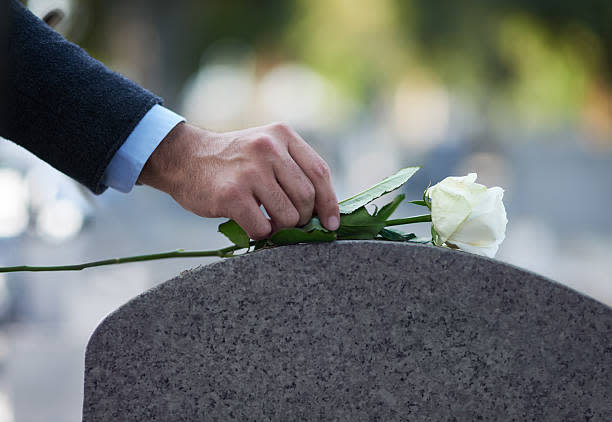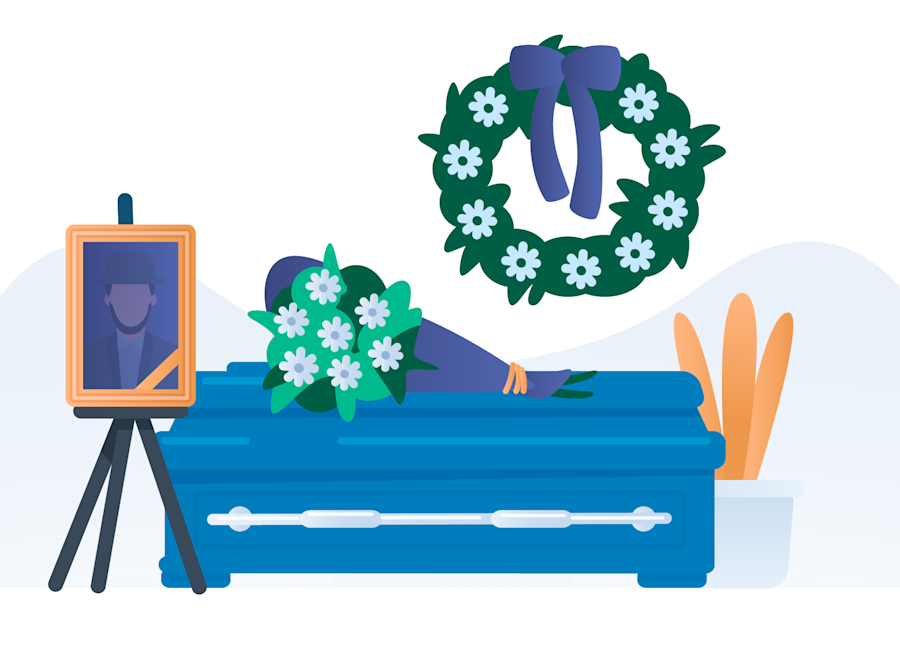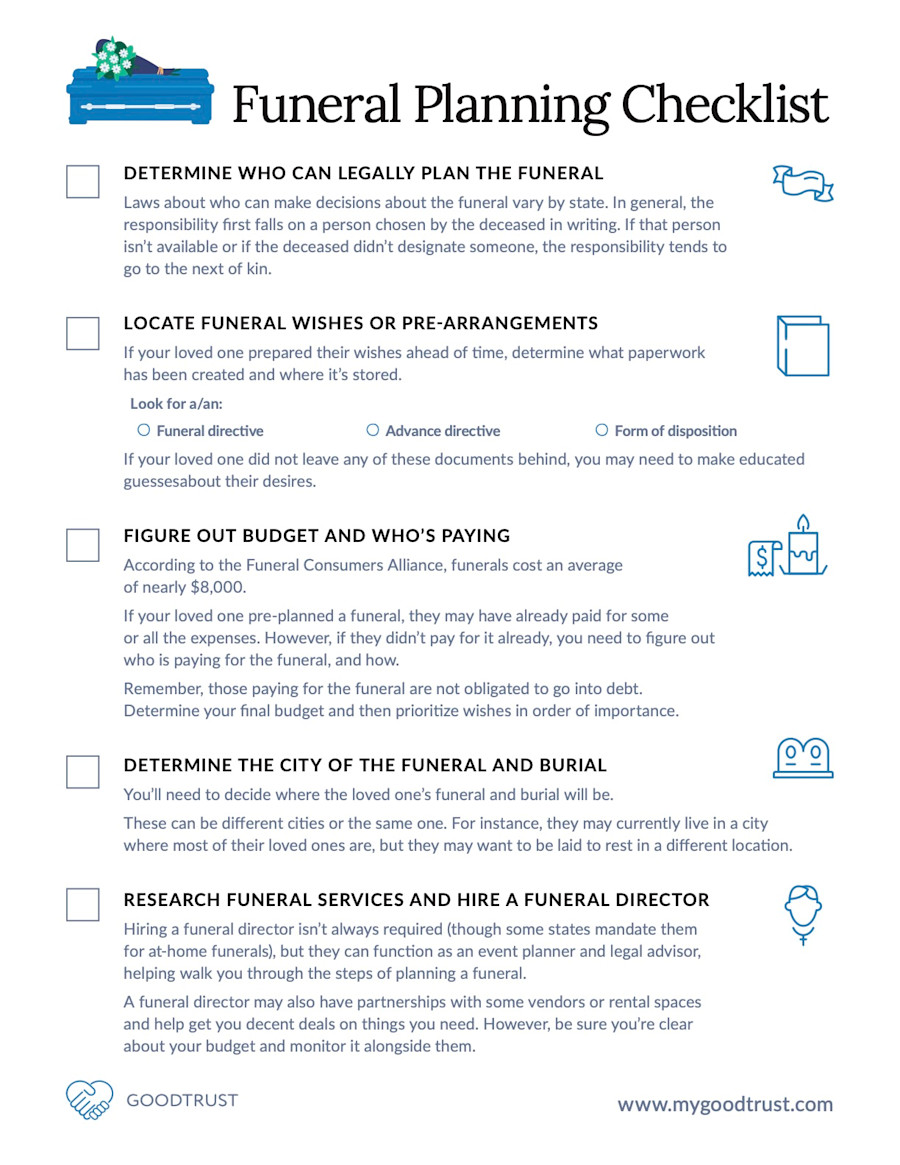
Estate Planning
10 Steps To Planning A Funeral | GoodTrust

Most funerals happen within one to two weeks of the death, barring legal concerns, weather, or the need to accommodate family and friends' schedules. This means when planning a loved one's funeral, you need to come up with memorial ideas fast.
Below, you can find out how to plan a funeral. Though these are the typical steps to funeral planning, they don't necessarily need to go in this order. Different cultures, beliefs, and families may have additional steps as well.
Click here to download our printable Funeral Planning Checklist
Note: Before focusing on the funeral, determine if the person wanted their organs donated. You can start planning the funeral while awaiting organ matching, but your loved one must be kept on life support during this time.

1. Determine Who Can Legally Plan the Funeral
Laws about who can make decisions about the funeral vary by state. In general, the responsibility first falls on a person chosen by the deceased in writing (often called a "designated agent"; in legal terms). However, if that person isn't available or if the deceased didn't designate someone, the responsibility tends to go to the next of kin.
You don't have to do this alone because you're the designated person or next of kin. Don't be afraid to delegate tasks, particularly to your loved one's trusted contacts or other close friends and family who can keep a cool head while working on the event. In an ideal situation, your loved one pre-planned their funeral, and all you have to do is execute their wishes. If they use a digital legacy service, chances are they've uploaded all their documents and preferences for easy access.
2. Locate Funeral Wishes or Pre-Arrangements
If your loved one prepared their wishes ahead of time, whether they thoroughly planned their funeral or wrote a list of preferences, the first thing to do is determine what paperwork has been created and where it's stored.
That paperwork could include, but isn't limited to:
Funeral Directive: List of instructions regarding funeral arrangements, including what to do with their body; separate from a will.
Living Will or Advance Directive: Usually only contain wishes regarding what you want to be done while you're still alive (especially important for organ donors) or with your body. Varies by state.
Form of Disposition: Form expressly about what they want to be done with their body after death; exists in some states, like Wisconsin, and may be part of or separate from an advance directive.
If your loved one did not leave any of these documents behind or did not complete them correctly, you may have some work to do.
You may need to take what you knew of the person and make educated guesses about their desires. Or you might want to talk to some of their closest friends and relatives to see if they ever brought up something they would want in the event of their death. You could even find some reference to their wishes in a social media post—an offhand Facebook comment or response to a question on Twitter could be very telling.
3. Figure Out the Budget and Who's Paying
According to the Funeral Consumers Alliance, funerals cost an average of nearly $8,000. Unfortunately, not everyone has thousands in cash on hand.
If your loved one pre-planned a funeral, they may have already paid for some or all the expenses. However, if they didn't pay for it already, you need to figure out who is paying for the funeral, and how.
In a perfect situation, your loved one or their family already set aside money for this via savings or prepaying a funeral home. While a life insurance payout may be expected, those funds don't often arrive before the funeral and may have to function as reimbursement.
So, figure out how much can be spent, who will be paying, and if anyone wants to chip in.
If the budget is only $2,000 and your loved one's final wishes would cost $10,000, this doesn't mean those paying are obligated to go into debt. Funeral wishes are generally not legally binding, and no one should be expected to go into debt to pay for a funeral.
Determine your final budget and then prioritize wishes in order of importance. Those with lower priority can be left out of the funeral plans.
4. Determine the City of the Funeral and Burial
You’ll need to decide where the loved one's funeral and burial will be.
These can be different cities or the same one. For instance, they may currently live in a city where most of their loved ones are, but they may want to be laid to rest in a different location.
Therefore, you may want to consider holding the funeral in one place and the burial in another. Or, you could opt for a small funeral in the burial location and a larger celebration of life in their current hometown later. (A benefit to this is you have more time to plan for the event.)
There are many legal and financial factors to moving a body, especially across state lines, so research your options and talk to your chosen funeral home, cemetery, or lawyer about what to do.
5. Research Funeral Services and Hire a Funeral Director
The days and weeks after someone dies are a whirlwind, meaning it could be pretty tempting to go with the first funeral service you find. However, to save yourself some money and ensure you get the service you want, set aside time to research local funeral homes, services, and directors.
Things to look up or speak to the funeral director about are:
The funeral director's involvement in planning, particularly if you need support
Itemized and overall costs
Whether faith factors into their services
If they can fulfill your loved one’s funeral wishes
If they require the service to be in a specific location
What, if anything, they offer other than funeral services, which could include: o Grief counseling o An event space o Discounts with specific burial sites or crematoria o Agreements with vendors like caterers
Hiring a funeral director isn't always required (though some states mandate them for at-home funerals), but they can function as an event planner and legal advisor, helping walk you through the steps of planning a funeral.
A funeral director may also have partnerships with some vendors or rental spaces and help get you decent deals on things you need. However, be sure you’re clear about your budget and monitor it alongside them.
Once you've talked to a few funeral homes, visit them in person—do a gut check. Do you feel comfortable with the location? Did the people you talked to seem sympathetic or more focused on making money? Were you pressured to sign documents immediately? Being comfortable with the people involved is essential.
If you're legally in charge of planning the funeral but don't have the emotional bandwidth to fully grasp what's you're told by a funeral home or place of worship (which is normal) bring a neutral third party, such as a friend of yours who didn't know the deceased, to help. Tell them precisely what you're looking for in a funeral service. The third party can help with the gut check, price comparisons, reading the fine print, and any negotiations without being emotionally invested in anything but your peace of mind.
Specialized Funeral Services
There are some specific types of funerals to investigate if relevant to your loved one. These include, but aren't limited to:
Military Funeral: Service for those who were involved with the military; may have partial coverage for expenses and offer other types of benefits.
Religious Service: Follows religious rites of their faith, including services and what's done with the body.
Non-Religious Service: Services with few to no mentions of faith.
At-Home Funeral: Holding the funeral at home; legal in all states but with some requirements varying.
Compromises may need to occur when deciding what type of funeral to hold, and preparing for those conversations is essential. Perhaps have a neutral third party help navigate those waters, such as the funeral director or a family therapist.
6. Fill Out a Form of Disposition
If the loved one didn't leave a form of disposition or other paperwork defining what they want to be done with their remains, the legally authorized representative must fill this out. This paper dictates what is to be done with the body, which could mean:
An open casket funeral
A burial
A natural burial (meaning no embalming and being buried in a natural cemetery or other location)
Cremation
Donating it to a research organization
Pick Out a Casket, Coffin, Urn, or Similar
Once you’ve established what will happen to the body, you need to decide on its storage. Typical options include:
Urn: A container for ashes; may be simple or ornate depending on individual and if ashes will be scattered
Casket or Coffin: A container in which someone is buried; can be simple or ornate and made of a variety of materials
Cremation Container: Like a casket or coffin, but often less ornate; used for funeral display, then cremated with the body
7. Choose Specific Locations for the Ceremony, Reception, and Final Resting Place
Once you've determined the funeral and burial cities, and type of service needed, start looking for the exact spots for the ceremony, reception, and final resting place. Your funeral director may be a great help here.
Choosing these locations should be based on what you know of the deceased. For example, would they want a natural or traditional burial? Would they dream of a church or outdoor service? Would they prefer their ashes to be scattered someplace or put on display in a home?
Decide on a Grave or Memorial Marker
If your loved one will be laid to rest in a grave or have their ashes scattered in a place where you can leave a marker, choose one that appropriately memorializes them and is allowed by the location.
Choose Décor and Create Funeral Programs
As part of choosing these locations, you may have the opportunity to decorate the space. This task is something you could potentially hand off to another person who knew your loved one well.
The most common décor includes flowers, candles, and photos of the loved one, but there is no wrong answer so long as your location permits your choices. If you're holding an event outside, keep environmental concerns in mind, from litter to rules against using anything flammable.
Funeral programs are papers or cardstock telling people what to expect during the service and, if relevant, where the burial location and reception will be. They usually include a photo of the deceased, birth and death dates and years, and perhaps a meaningful quote.
What to Consider for the Reception
The reception can be as somber or celebratory as you want. You can always pass the reception plans off to someone else who you trust to invite the right people and set the right tone.
Choosing a location is, of course, the first step. Consider how many people you need to have room for, what they allow (e.g. do they allow alcohol?), accessibility needs, cost, etc., before putting down a deposit.
Once you've chosen a location, you can determine a theme and tone (e.g. somber vs. light). Then, decide on decorations, ways to memorialize them, whether speeches will be given, if you want to find music or use songs from the loved one's Spotify or Pandora, and anything else you would plan for a typical party.
8. Create a Guest List and Invite People
Since there's often very little time between a death and a funeral, the ability to create a perfect guest list and send out invitations is limited. This is a step in which getting help is highly recommended.
Remember, you aren't required to invite people to both the funeral and the reception. The funeral can be open to the public, but you may only invite close family and friends to the reception or burial. Collaborate with those closest to your loved one to create the guest list.
To expedite the process, invitations may need to happen via phone, email, or social media event. An email invitation may sound a bit tacky, but many invitation sites have beautiful funeral invitation templates you quickly email to all people on your list.
If your invitees are primarily on social media, you could also create a private event so they can RSVP, share memories, and grieve together online.
If you can take more time between the death and the service—for instance, if the body is being cremated—you can send traditional invitations via the mail. You can have someone else take charge of monitoring the RSVPs if you want.
9. Choose Who Will Speak at the Ceremony
If your loved one didn't specify who they would want to speak at their funeral or memorial service, you could help determine who does so.
Talk to family members and close friends, and clarify they're allowed to say "no" if they're uncomfortable.
Common types of funeral readings and speeches are:
Eulogy: An in-depth speech written by the speaker sharing some highlights from the deceased's life. Depending on the situation, it can be formal or informal, light or somber, or a mix of all types. If your eulogist needs help, you can provide them with eulogy samples and templates.
Religious Text Passages: If you're having a religious ceremony, the officiant or a loved one can read the deceased's favorite passage, a passage reminding them of that person, or something they believe will bring comfort.
Non-Religious Passages: Whether or not the ceremony is religious, non-religious texts are often welcomed. Like religious text passages, they serve the same purposes without the basis in faith.
Impromptu Speeches: In more casual celebrations of life or memorial services, you can have a couple of formal speakers and then ask if anyone wants to share memories of their lost loved one publicly. This can also be reserved for the reception. Only use this option if you think people are likely to volunteer.
In addition to speakers, choosing friends to sing or play music is also common.
10. Ask for Donations (Optional)
Asking for donations at a funeral is common. Donations frequently go to a favorite charity, a scholarship fund for the deceased's children, or toward the funeral and medical costs owed by the family.
How to Plan a Funeral While Grieving
Since it's common for the next of kin to be responsible for making the big decisions about a funeral, you may not feel emotionally ready to make these choices. Unlike other types of events, you often only have two to four to plan the entire funeral.
Luckily, many aspects of funeral planning can be handed off to or co-planned with someone else.
Additionally, even though you often must make final legal decisions alone, you can ask a funeral director or lawyer for help. You could often also ask a level-headed friend or family member to come along for moral support or to help you figure out the best routes to take.
You could consider seeking help from a therapist or counselor during this time. Though it can be hard to get into in-person therapy quickly, online-only options are increasing, and you can often find someone to help within a couple of business days. Your funeral director may also be able to refer you to someone.
A mental health professional can't necessarily help you make hard choices, but they can help you find coping methods for your feelings surrounding making those choices.
If you find yourself disagreeing with other family members or friends over details, having a neutral party like your funeral director, lawyer, or family therapist could also help deal with these issues.
In short—you aren't strange for feeling overwhelmed or like you need help, and it's okay to ask for help.
Benefits of Online Legacy Services While Funeral Planning
Online legacy services like GoodTrust allow your loved one to store important documents, like funeral plans and last wills and testaments, in one place.
In addition to protecting essential documents, our digital legacy service can assign people to handle things like closing bank accounts, memorializing social media pages like Facebook or Twitter, and more.
We’re here to help take the guesswork out of end-of-life planning for you and your loved ones. Sign up for a free account today.